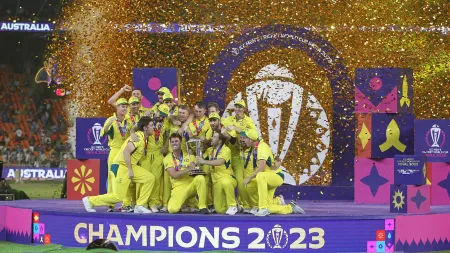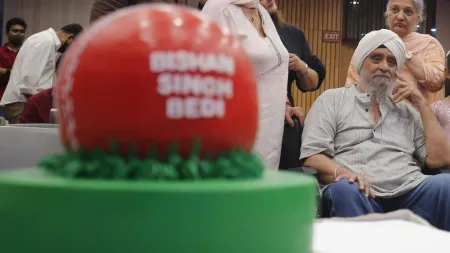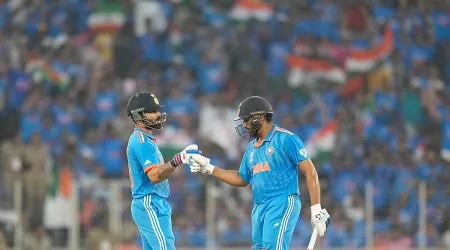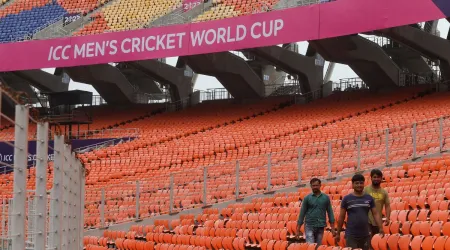- India
- International
Story of Motera stadium: The political turf where Sunil Gavaskar and Kapil Dev broke world records
Political games have always sprung up from the ravine of the world’s new largest stadium since its inception in 1980s. The Indian Express digs up the story of the old Gujarat Stadium, the epicenter of all political goings-on which refuses to go down as a footnote in history.
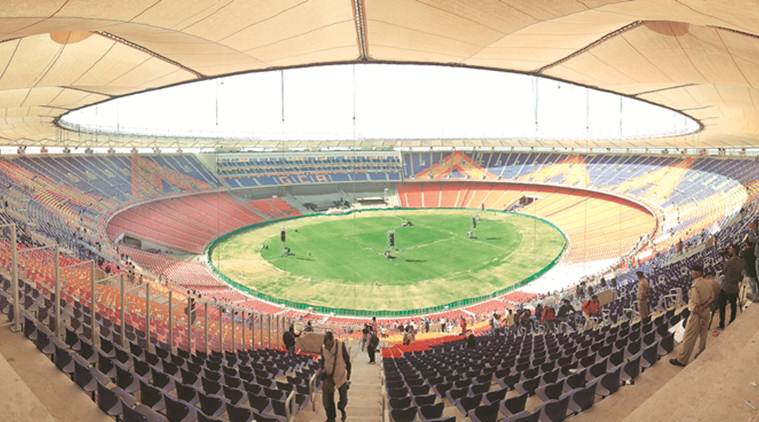 The shiny new wonder, Motera stadium, can host a lakh and ten thousand people and will become the largest cricket stadium in the world. (Express Photo: Javed Raja)
The shiny new wonder, Motera stadium, can host a lakh and ten thousand people and will become the largest cricket stadium in the world. (Express Photo: Javed Raja)
Donald Trump loves BIG things. Nothing in Indian Test cricket got bigger than Sunil Gavaskar’s 10000 runs and Kapil going past Hadlee, both at the Motera where the US President is set to strut about in a Kem Cho Trump event. But political games have always sprung up from the ravine of the world’s new largest stadium since its inception in 1980s. Sriram Veera digs up the story of the old Gujarat Stadium, the epicenter of all the political goings-on which refuses to go down as a footnote in history.
FOR THE past few weeks, all routes from Ahmedabad airport to the new cricket stadium in Motera have been the most fussed pathways in India. For the ‘Kem cho Trump’ event (Howdy Trump, in Gujarati), some roads have been resurfaced, a few narrow lanes widened out to act as alternate routes, and pretty flowers flutter atop a newly constructed six-feet-tall and kilometre-long wall that would curtain out slums from Donald Trump’s vision. Not just Trump and Narendra Modi but even the venue’s an eye-ball grabber. The shiny new wonder can host a lakh and ten thousand people and will become the largest cricket stadium in the world.
The old stadium though refuses to remain a mere footnote in India’s cricket and political history. The 63 acres of earth, a ravine land in 1982, a large pit of banjar aur khadda zameen that transformed into a stadium in just eight months, has thrown up a fascinating potboiler: ambitions of Mrugesh Jaikrishna, then 38-year-old president of Gujarat cricket association and a fast-rising textile mills scion, his wife Parul, who went on to become a renowned industrialist, cameos by Congress politicians like Indira Gandhi as well as Narhari Amin who administrated sports organisations.
 2009: Narendra Modi became GCA president in 2009 with Amit Shah as the vice-president. In 2014, just after Modi became the Prime Minister, Shah took over as the president of the association.
2009: Narendra Modi became GCA president in 2009 with Amit Shah as the vice-president. In 2014, just after Modi became the Prime Minister, Shah took over as the president of the association.
Motera was the magical cauldron that stirred up cherished Indian cricketing landmarks – panama-hatted Sunil Gavaskar breaching the 10,000-run barrier in Tests, toothy-grinned Kapil Dev watching 432 balloons floating out of the stadium just after he went past Richard Hadlee’s most Test wickets, Javagal Srinath’s reverse-swinging spell from hell that dismantled South Africa, and Rahul Dravid’s 11,000th Test run.
Read | Explained: With 1,10,000 seats, Motera cricket stadium set to become largest in world

It also fired up a debate on another pitch, the political one, in Lok Sabha when Prof Madhu Dandavate, a physicist and a Janata Party politician, brought up Mrugesh’s political connections pointing fingers at the Motera.
***
Mrugesh Jaikrishna is now 76. The avuncular voice — soft, calm, friendly — and a gentle ease pervades his anecdotal memory. In his heyday with cricket in the early 80’s, Mrugesh was also vice-president of the Indian cricket board (BCCI). His industrialist father Jaikishan Harivallabhdas started textile mills when Ahmedabad was renowned as a cotton town but which were in terminal decline by the mid 80’s.
The desire for a stadium partly stemmed from humiliation he faced in a meeting with the veteran officials of the Indian cricket board. In 1981, he had just come back from Pakistan, where India were playing a cricket series. “I had gotten friendly with a few players, they shared some of their concerns. I also grew close to Jagmohan Dalmiya, IS Bindra, Rajsingh Dungarpur, and NKP Salve. On my return to India, when I rose from my seat to offer some suggestion, the senior members shouted, “sit down, you sit down, you are young, what do you know?” And a few other unpleasant things.
“Self-respect bhi koi cheez hoti hai,” Mrugesh pauses. “It was also said around that time that only associations which have their own cricket grounds would be able to host matches.” A rankled Mrugesh returned to Ahmedabad with one thought. “I requested the chief minister that we should build a stadium.”
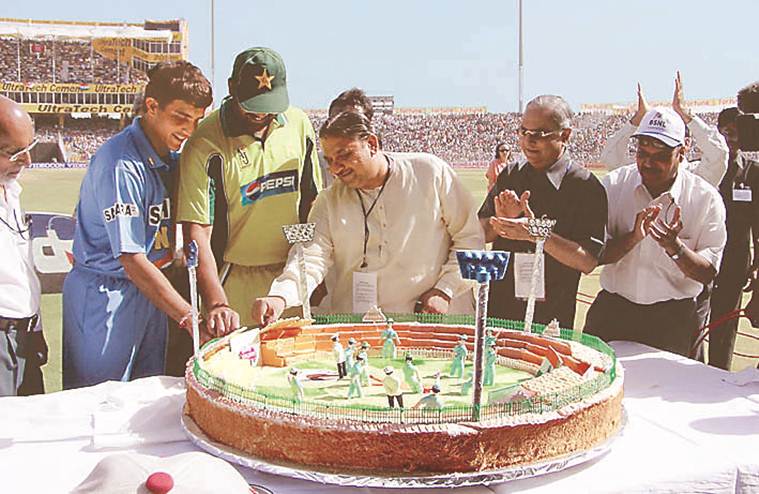 2005: Congress’ Narhari Amin, who was GCA president for 16 years from 1993 and joined BJP in 2012, cuts a stadium-shaped cake along with captains Sourav Ganguly and Inzamam-ul-Haq.
2005: Congress’ Narhari Amin, who was GCA president for 16 years from 1993 and joined BJP in 2012, cuts a stadium-shaped cake along with captains Sourav Ganguly and Inzamam-ul-Haq.
Mrugesh’s father had already been mayor of the city for many years. In political circles Mrugesh came to be known for his proximity with the Congress Chief Minister of Gujarat Madhavsinh Solanki.
“If I was considered so close to the CM, then the land should have been free. Or at least, at a prime location as stadiums are in Mumbai, opposite Marine Drive, and in Bangalore, on MG Road in city centre,” Mrugesh says now. “In fact, not a single paisa was given by the Gujarat state government for construction. We had to scramble around for money. And the land given was not only in the outskirts of the city (Ahmedabad has spread out in 37 years that Motera isn’t that off) but it was a ravine.” Photographs attest to that and while the land wasn’t free, it was reportedly given at Rs 8 per square metre.
It took Rs 29 lakhs to fill up the ravine and level the land, says Mrugesh. “No money from government, remember, and that was 1982, the Indian cricket board’s coffers weren’t so full as it is now,” Mrugesh says.
Mrugesh hit upon a plan. To sell air-conditioned corporate boxes for Rs 4.5 lakh each. “No one came forward to buy in this so-called industrialised city,” he recalls. He bought two boxes and decided to tap his industrialist friends and relatives for the rest. “Sintex company was run by my maasa (mother’s sister’s husband), Nirlon (my father was chairman), Mafatlal, my maasa again, and then from a friend. In all we sold just eight boxes, five to relatives. Now, they are selling corporate boxes for Rs 4 crores – and people are lining up. How times have changed!”
With Rs 35 lakhs in the kitty, he plunged into filling up the ravine. 15 bulldozers were put to work. Since it was a race against time – they had to be ready in eight months to host the Test against West Indies —Mrugesh was under the kosh. “I hired three contractors to cook food and snacks for workers on site. I am so thankful to the workers who toiled all day for months.”
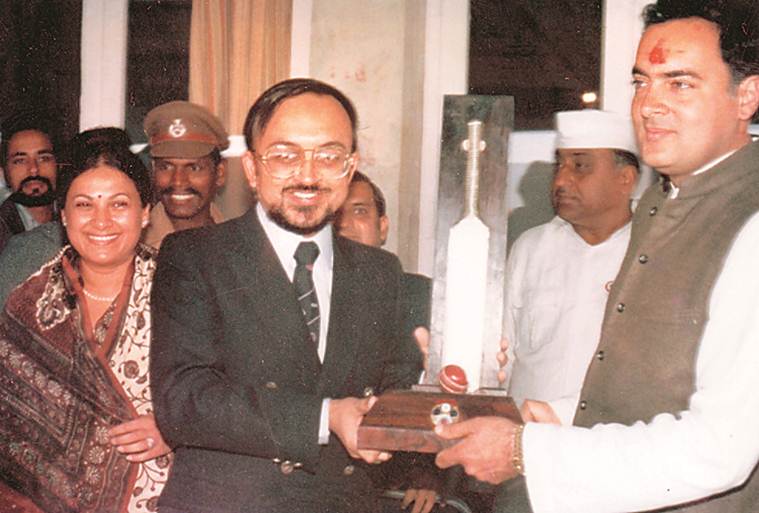 1984: Then Prime Minister Rajiv Gandhi, who had even visited the site during construction, felicitates Mrugesh Jaikrishna for the stadium in 1984.
1984: Then Prime Minister Rajiv Gandhi, who had even visited the site during construction, felicitates Mrugesh Jaikrishna for the stadium in 1984.
Money might not have come for the construction but state patronage was extended by other means. Many governmental public sector organisations were asked to become Life Members of the Gujarat cricket association by contributing money. Even the Slum Clearance department.
Rest of the money was obtained from loans from co-operative banks says Mrugesh. “I had to give personal collateral. Nothing came from the government; it’s not as if I could walk into any bank and money was given.”
***
Even before his stylishly-late cut in 1987 that brought up his 10,000th Test run and tattooed itself in the minds of Indian cricket fans, Gavaskar had a connection with the ground. Part of the advisory board set up by Mrugesh to track progress of the construction, he had walked in the rubble and holes of the ravine that was transforming into a stadium where he would accomplish his historic barrier-crossing.
That 10,000th run had come in March 1987 on back of anxious wait for the fans as runs weren’t flowing in the customary ‘SMG’ way. That evening he spoke to Doordarshan. “I was very keen to get it done fast. It was getting to me, everybody meeting me going 10,000, 10,000 – so I am really happy that’s past now.” Relief first before the full import of the achievement came.
Luckily, there exists a YouTube video with a news clip about the crossing – the panama hat dug into his chest can be seen and the faces of those who have watched him bat would crease into a smile at the sight of how quickly Gavaskar recovers from his relief-tinged-joy to look for more runs; he brings down the raised bat around mid-pitch during the first run, and dashes not just for the second but also casts a glance at Dilip Vengsarkar exploring the possibility of the third. Only after resigning to the fact that an extra run can’t be squeezed, does he turn, pump his bat up, and raise his left hand to acknowledge the applause.
Kapil Dev conjured a champagne bottle in the dry state that evening to celebrate Gavaskar’s tryst with history.
***
Even in the first match at the new stadium in ‘83, Gavaskar had scored a valiant 90 in the first innings against West Indies though India lost in four days. That Test series was part of the Gavaskar folklore and also for West Indies crushing India after the world cup loss by winning three Tests and five ODIs. Malcolm Marshall’s lifter knocked Gavaskar’s bat off his hands in the first Test at Kanpur, casting a dark pall for the moment but would eventually be talked up by his fans for years as the moment that triggered his thrilling counter-attacking knocks that followed in the series.
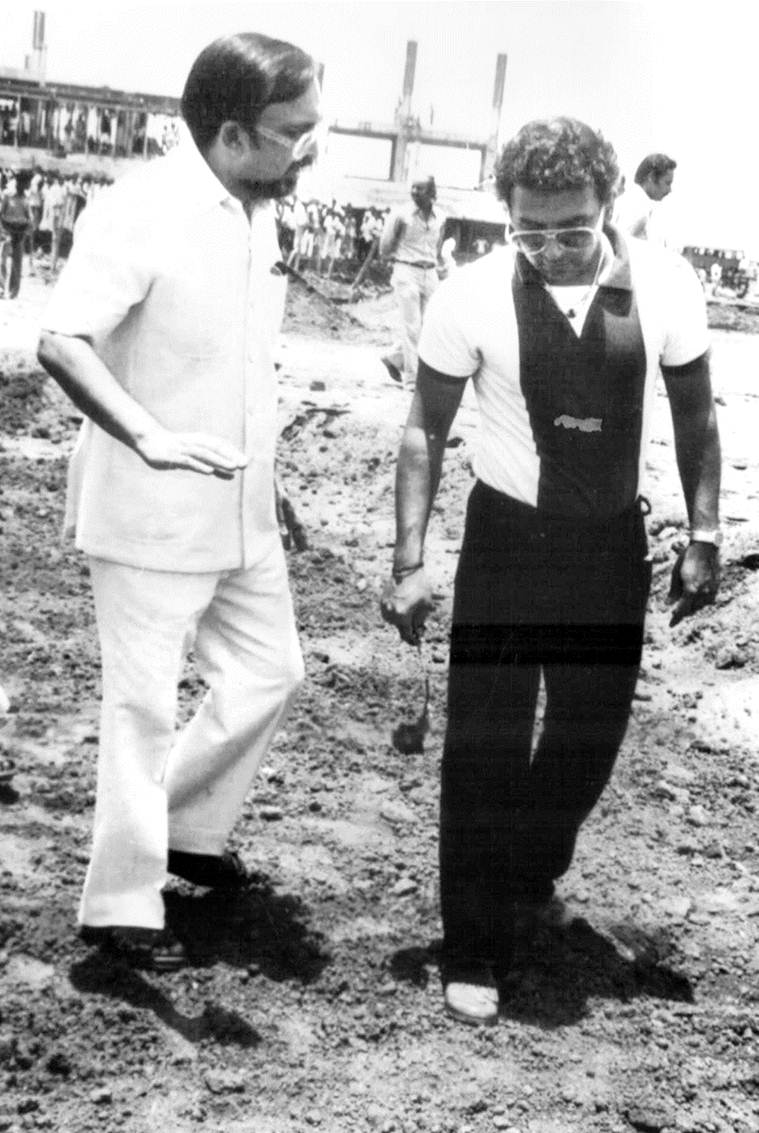 1983: Mrugesh Jaikrishna with Gavaskar, part of the advisory group to track construction.
1983: Mrugesh Jaikrishna with Gavaskar, part of the advisory group to track construction.
How he roused himself in the next Test in Delhi, hooking and pulling Marshall and Michael Holding – the fifty came in 37 balls, and the 100, the Bradman-equalling 29th, in 94 balls. So, focussed was he that it was left to Dilip Vengsarkar to yell out, “Bloody hell, it’s your 29th!”. A Test later, he was in Ahmedabad where he hit 90 that earned the raves from Vijay Merchant. In the next two Tests, Marshall took him out three times for 12,3,0 and Holding took him once for 20. He batted at No. 4 in the final game, but walked in at 0 for 2 and smashed a double hundred, his highest Test score of 236.
Mrugesh fondly remembers the evening after the first game at the new stadium when players from both teams landed up at his house for a party. The evening to remember had come on the back of a lot of turmoil. The politics had continued to unravel. The state Congress was split into two factions – pro CM and anti-CM or as Mrugesh saw it, “those who wanted the stadium and those who didn’t. Some 15 petitions were filed by random organisations against the construction on one silly pretext or other. Since our cricket association members had day jobs, I had to run from court to court.”
It was then his wife Parul — who would by the end of decade start a chemical company Asahi Songwon that would rise to become world leader — stepped in. “She would be walking around the construction, from morning to night, supervising the work. Every day, for months. The cases were disposed off one by one but it was draining.”
More trouble awaited. Mrugesh had begun to fret about the various governmental arms that would demand free passes in thousands. Else, he feared that blackmails of cutting off water supply or security would throw spanners in the works.
“I wasn’t a bewakoof, a fool. I went to Chief Minister Solanki and asked them to issue statements to newspapers as a way to encourage a new stadium, we will buy tickets. No passes. They agreed. I am telling you on oath, I had two young boys then and inspite of buying two corporate boxes, I bought tickets for them, just to set an example.”
The stadium was supposed to be named after Indira Gandhi but Gujarat Chief Minister Solanki’s critics, they say, persuaded her to not lend her name. Eventually, it was called ‘The Gujarat Stadium’.
***
In between Gavaskar’s memorable moments at the stadium, spread over four years, Mrugesh’s fortunes would rise and sink. The euphoria of the stadium was briefly punctured in 1985, his name mentioned in the parliament.
On March 29th 1985, in the Lok Sabha, Prof Madhu Dandavate, the socialist from Janta Party kicked up a storm, by raising an Attention to Motion to VP Singh, the union finance minister then, on confiscation of foreign currency and travellers’ cheques worth Rs 46 lakhs. Police had swooped down on those involved, including Mrugesh.
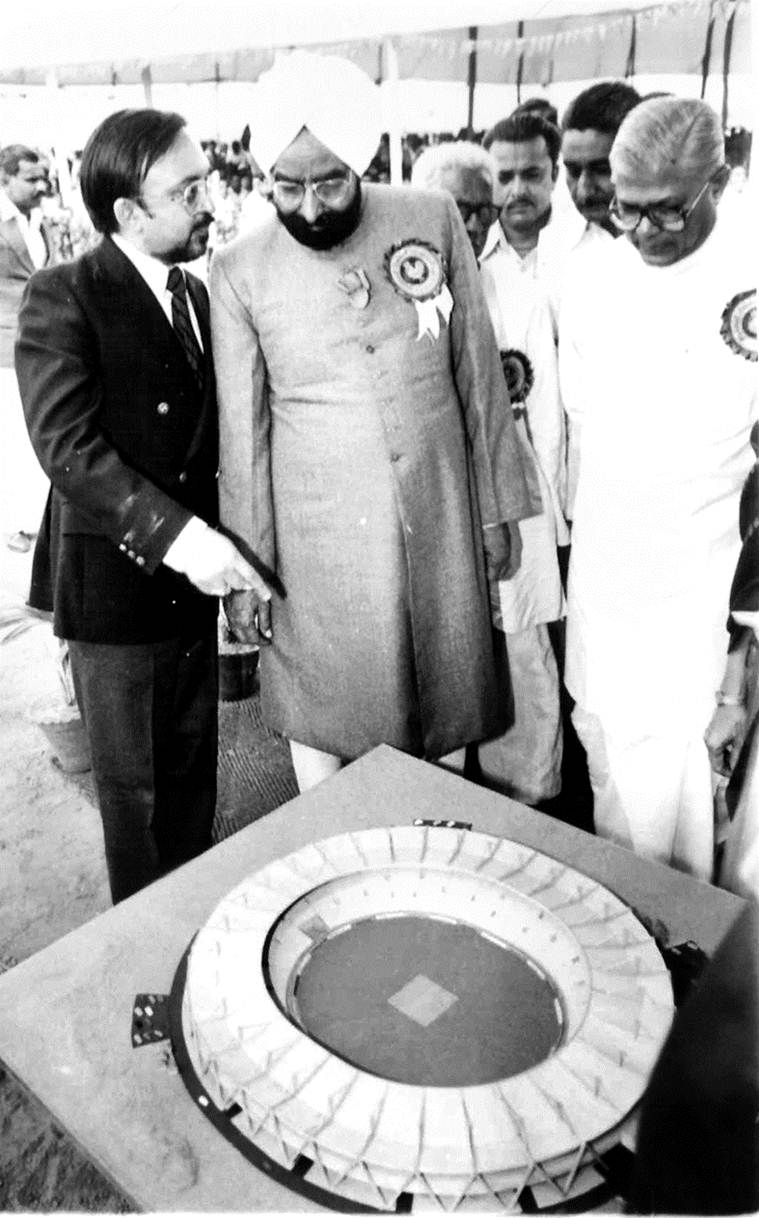 1983: Mrugesh Jaikrishna, man behind Motera, with then President Giani Zail Singh at inauguration of the stadium.
1983: Mrugesh Jaikrishna, man behind Motera, with then President Giani Zail Singh at inauguration of the stadium.
Thirty-four years after the scandal, Mrugesh reiterates his innocence. “It was a political thing. Nothing was found in any section of law. And as for money for construction, I told you what kind of ravine land it was. And how I had to raise all the finances for it.”
In the parliament, after he mentions the incident at the Customs and police action, Dandavate brought up the stadium: “I want to know whether the Chief Minister of Gujarat obliged Mr. Mrugesh Jaikrishna, who is the Vice President of BCCI and the President of Cricket Control Board of Gujarat, in constructing a new stadium near Gandhi Nagar by giving away 50 acres in throw-away prices.”
There was one more political drama involving the stadium that tumbled out in the parliament. Dandavate again, “Is it not a fact that Shrimati Indira Gandhi responded favourably and persuaded the chief minister to dissociate her name from the stadium,” he asks. The debates from each day’s sitting of the Parliament have been digitalised, an engrossing rabbit hole to disappear in for hours.
When the stadium was eventually ready, President Giani Zail Singh, a friend of IS Bindra’s, agreed to inaugurate it. By then, Mrugesh also was part of a new power centre in BCCI with the leadership of Jagmohan Dalmiya and Bindra. “I remember when we crossed over and had just four-five members in a board where majority of power lay with Mr Wankhede. The Times of India carried a story, headlined, ‘Gujarat defects from majority to minority’!”
***
“You know what is Indian politics? People move towards power. Simple,” Mrugesh says. “I knew my end was near. I had alienated the passes-hungry people and a whole lot of others in construction. And they hit back with other politicians.” In 1993, ten years after he had built the stadium, Mrugesh was replaced by the Congressman Narahari Amin; the Deputy Chief Minister in the cabinet of CM Chimanbhai Patel, who became president of the cricket association.
Amin had his own battles to face. In particular, the financial crunch in the association. “Mrugesh did build the stadium against all odds, no doubt about it, but we were in debt when I came on board. Also, the other infrastructure needed to be built,” Amin tells The Sunday Express. “It had a debt of Rs 8 crore.”
Amin and his men, that included the diligent Hitesh Patel, known as ‘Pochi bhai’ and eventually the joint-secretary of the association, got to work. “Amin sir met with all the banks and private individuals who had lent money, some of whom had gone for litigation,” Patel says. “Most of them agreed that they would take back the principal, and forget the interest. Indian Bank and co-operative banks were paid back.” Four grounds came up around the main stadium, within the 63 acres. An indoor stadium, a club house, grounds where age-group matches can be held all sprang up. Cricket began to flourish locally. Amin held the post for 16 long years, and when he was replaced by BJP’s Amit Shah in 2009, Amin says the association was in Rs 45 crores profit. For the first few years of Shah’s rule, Amin would fire criticisms about how it was run and how cricket at districts were lagging but in 2012, he joined BJP in presence of Modi.
Motera stadium continued to throw up special moments. In Amin’s tenure, Kapil became the highest wicket-taker in the world on this ground.
On an impulse, his wife Romi had flown to Bangalore the evening before the last day of the preceding Test when Kapil still needed three wickets to break Hadlee’s record. Sri Lanka had just three wickets left and Romi saw her husband pick up two next morning to equal Hadlee. In the dressing room, Kapil threw a towel over his head and cried his heart out. “This was probably the safety valve working. For years, I had been the strong man, unable to shed a tear, unwilling to let my heart bear the burden of the world. As I wept, I saw world differently,” Kapil would say later. A cake on which 431 was inscribed was cut by Kapil that evening.
Along with family and friends, Romi reached Ahmedabad. The city, in particular the stadium, was flooded with images of Kapil. One boundary hoarding at the ground during the match read: ‘One “Vital” wicket left! Come on Kapil!’. When the Sri Lankan Hashan Tillakaratne thudded his bat on the ground as Kapil ran in for that wicket-taking ball, an hour or so into morning’s play, that hoarding flashed on the deep midwicket boundary. A moment later Kapil was leaping, both arms in air just after Sanjay Manjrekar took the catch off the inside edge at short leg.
432 balloons were released by the cricket association. Doordarshan celebrated the moment by playing a song in Kapil’s tribute – “Haqeeqat hai ye khwab nahin / Kapil Dev ka jawaab nahin.” That evening, a party was thrown at sports club in the city. In the dressing room, before that, the team celebrated and images of Kapil dancing on top of a table, a glass of drink on his head supported by his left hand, would freeze in minds of fans.
***
All the Motera characters continued to have interesting lives. Pochi bhai runs a cricket club and still has his afternoon tea topped with sugar and gossip with the current office bearers.
Parul perhaps had the most spectacular rise of them all. When the textile mills of her husband and father-in-law shut down, she sent her two kids Gokul and Munjal to study postgraduate degrees in Finance and Marketing abroad. She started a flourishing chemical company; they have just signed a joint venture with a major UK company to start a plant in England. Mrugesh is part of the board of directors and their sons and grandsons take care of the companies. They stay in a lovely farmhouse near the Ahmedabad airport. “I was a son of a big textile businessman, yes. But at that stage in my life, I was a young civilian who had a brush with politicians and sportstars, and constructed a special stadium. That phase wasn’t always rosy but it was a great journey,” Mrugesh says.
The gaping hole in Motera has filled so many people, administrators, politicians, and players with joy and is now shape-shifting into the largest stadium in the world. Not bad for a ravine.


















